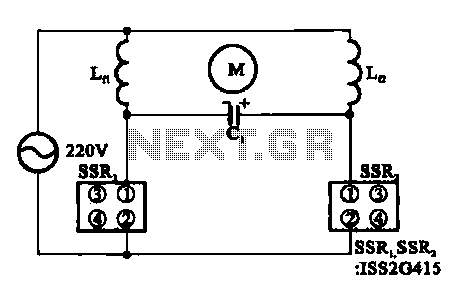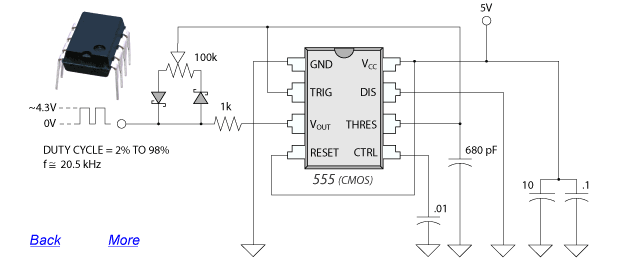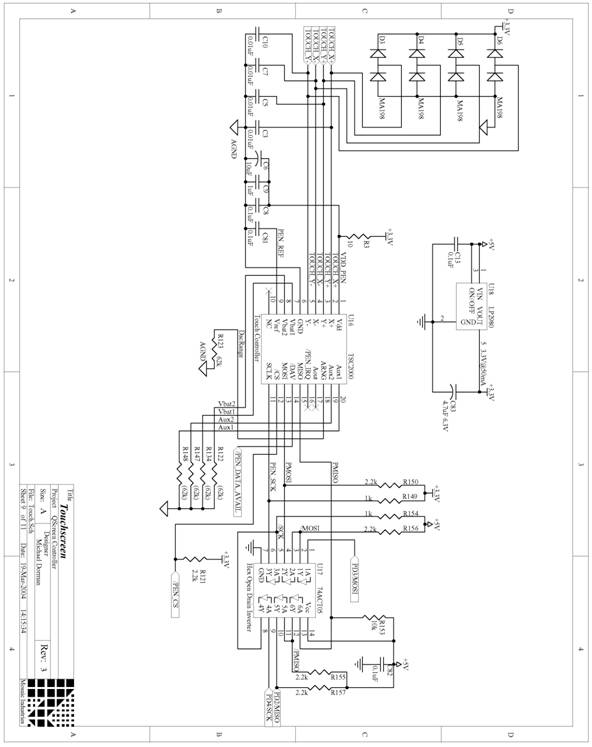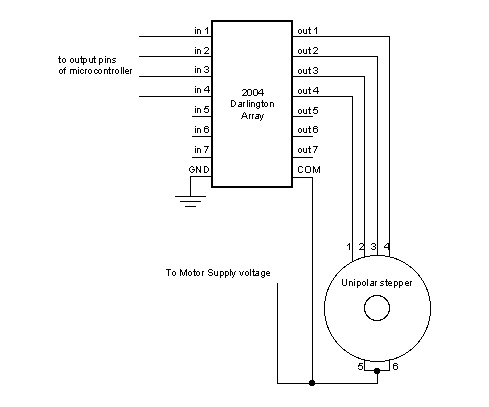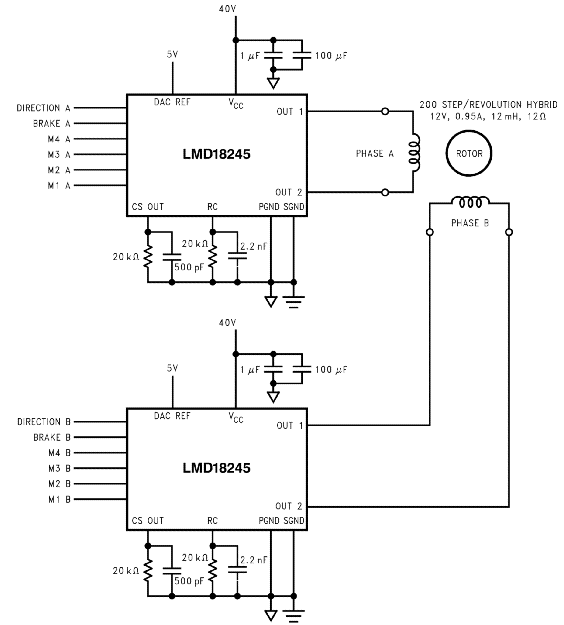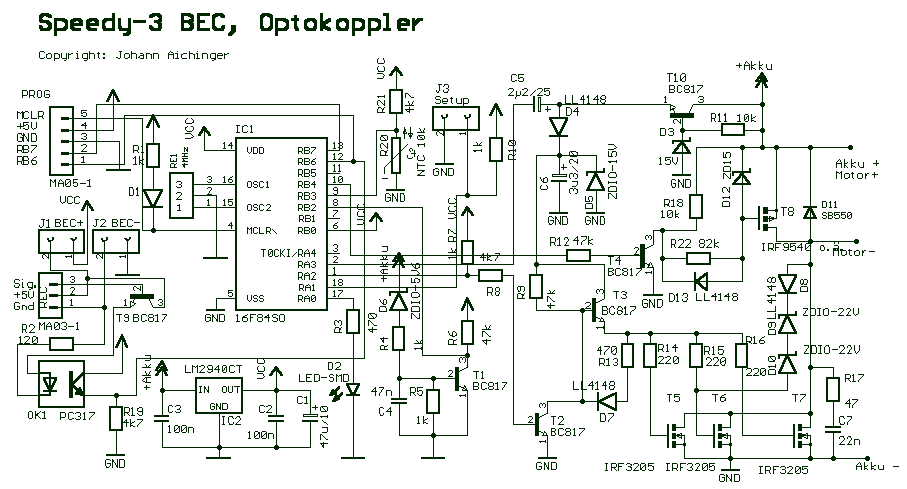
wireless motor control through rf

DC motors can be operated remotely using controls transmitted via an RF module. This circuit employs an RF module to manage DC motors through a motor driver integrated circuit (IC) L293D. Transmission is initiated by setting pin 14 (TE, active low) of the encoder HT12E to a low state. Controls for the motors are sent to the HT12E, where pins 10 and 11 (D0-D1) are designated for one motor and pins 12 and 13 (D2-D3) for another. The data signals from the encoder HT12E utilize negative logic, meaning a specific signal is transmitted by applying a low bit to the corresponding data pin of the encoder. The parallel signals generated at the transmission end are first encoded into serial format by HT12E and then sent via an RF transmitter operating at 434 MHz, with a baud rate of approximately 1-10 kbps. The RF receiver captures these signals, which are subsequently decoded by HT12D. Due to the negative logic of the encoder/decoder pair, the decoded signals are processed through an inverter (NOT gate) IC 74LS04. The inverted signals are then directed to L293D. This IC contains two integrated H-bridge driver circuits, allowing for the simultaneous operation of two DC motors in both forward and reverse directions. The operation of the motors can be controlled by input logic at pins 2 & 7 and pins 10 & 15. Input combinations of 00 or 11 will halt the corresponding motor, while logic states of 01 and 10 will rotate it clockwise and counterclockwise, respectively. Consequently, based on the signals generated at the transmission end, the two motors can be rotated in the desired directions. The RF module operates at radio frequencies, typically ranging from 30 kHz to 300 GHz, where digital data is represented through variations in the amplitude of the carrier wave, a modulation technique known as Amplitude Shift Keying (ASK). RF transmission offers advantages over infrared (IR) communication, such as greater range and the ability to penetrate obstacles, making it suitable for long-distance applications. Additionally, RF signals are more robust and reliable than IR signals, which can be disrupted by other IR sources. The RF module consists of an RF transmitter and an RF receiver, both operating at a frequency of 434 MHz. The RF transmitter captures serial data and wirelessly transmits it through its antenna connected at pin 4, with a transmission rate of 1Kbps to 10Kbps. The RF receiver, tuned to the same frequency as the transmitter, receives the transmitted data. This RF module is frequently used in conjunction with a pair of encoder/decoder ICs, such as HT12E - HT12D or HT640 - HT648, to facilitate the encoding of parallel data for transmission and its subsequent decoding upon reception.
The circuit design integrates several key components for effective operation. The HT12E encoder is responsible for converting parallel data inputs into a serial format suitable for RF transmission. The RF transmitter then modulates this serial data and transmits it wirelessly. Upon reception, the RF receiver demodulates the signal, and the HT12D decoder converts the serial data back into parallel form for further processing. The inverter (74LS04) is crucial for adjusting the logic levels from the decoder to match the requirements of the motor driver IC (L293D). The L293D IC is particularly advantageous because it allows for the control of two DC motors, enabling simultaneous operation in both directions. The H-bridge configuration within the L293D permits efficient control of motor speed and direction through the application of specific logic levels to its input pins. Overall, this RF-controlled DC motor system exemplifies a robust solution for remote motor management, leveraging the benefits of RF communication to enhance operational flexibility and reliability.The way DC motors can be driven by using the controls from a distant place. The controls are transferred from one end to another by employing an RF module. This circuit uses RF module to control DC motors through a motor driver IC L293D. Transmission is enabled by giving a low bit to pin14 (TE, active low) of encoder HT12E. The controls for motor are first sent to HT12E. Pins 10 and 11 (D0-D1) are used to control one motor while pins 12 and 13 (D2-D3) to control another motor. The data signals of encoder HT12E work on negative logic. Therefore a particular signal is sent by giving a low bit to the corresponding data pin of encoder. The parallel signals generated at transmission end are first encoded (into serial format) by HT12E and then transferred through RF transmitter (434 MHz) at a baud rate of around 1-10 kbps. The same signals are acquired by RF receiver after which it is decoded by HT12D. For more details, refer RF remote control. Since the encoder/decoder pair used here works on negative logic, the decoded signals are fed to an inverter (NOT gate) IC 74LS04.
The proper (inverted) signals are then supplied to L293D. L293D contains two inbuilt H-bridge driver circuits to drive two DC motors simultaneously, both in forward and reverse direction. The motor operations of two motors can be controlled by input logic at pins 2 & 7 and pins 10 & 15. Input logic 00 or 11 will stop the corresponding motor. Logic 01 and 10 will rotate it in clockwise and anticlockwise directions, respectively. Thus, depending upon the signals generated at the transmission end, the two motors can be rotated in desired directions.
The RF module, as the name suggests, operates at Radio Frequency. The corresponding frequency range varies between 30 kHz & 300 GHz. In this RF system, the digital data is represented as variations in the amplitude of carrier wave. This kind of modulation is known as Amplitude Shift Keying (ASK). Transmission through RF is better than IR (infrared) because of many reasons. Firstly, signals through RF can travel through larger distances making it suitable for long range applications. Also, while IR mostly operates in line-of-sight mode, RF signals can travel even when there is an obstruction between transmitter & receiver.
Next, RF transmission is more strong and reliable than IR transmission. RF communication uses a specific frequency unlike IR signals which are affected by other IR emitting sources. This RF module comprises of an RF Transmitter and an RF Receiver. The transmitter/receiver (Tx/Rx) pair operates at a frequency of 434 MHz. An RF transmitter receives serial data and transmits it wirelessly through RF through its antenna connected at pin4.
The transmission occurs at the rate of 1Kbps 10Kbps. The transmitted data is received by an RF receiver operating at the same frequency as that of the transmitter. The RF module is often used alongwith a pair of encoder/decoder. The encoder is used for encoding parallel data for transmission feed while reception is decoded by a decoder.
HT12E - HT12D, HT640-HT648, etc. are some commonly used encoder/decoder pair ICs. 🔗 External reference
The circuit design integrates several key components for effective operation. The HT12E encoder is responsible for converting parallel data inputs into a serial format suitable for RF transmission. The RF transmitter then modulates this serial data and transmits it wirelessly. Upon reception, the RF receiver demodulates the signal, and the HT12D decoder converts the serial data back into parallel form for further processing. The inverter (74LS04) is crucial for adjusting the logic levels from the decoder to match the requirements of the motor driver IC (L293D). The L293D IC is particularly advantageous because it allows for the control of two DC motors, enabling simultaneous operation in both directions. The H-bridge configuration within the L293D permits efficient control of motor speed and direction through the application of specific logic levels to its input pins. Overall, this RF-controlled DC motor system exemplifies a robust solution for remote motor management, leveraging the benefits of RF communication to enhance operational flexibility and reliability.The way DC motors can be driven by using the controls from a distant place. The controls are transferred from one end to another by employing an RF module. This circuit uses RF module to control DC motors through a motor driver IC L293D. Transmission is enabled by giving a low bit to pin14 (TE, active low) of encoder HT12E. The controls for motor are first sent to HT12E. Pins 10 and 11 (D0-D1) are used to control one motor while pins 12 and 13 (D2-D3) to control another motor. The data signals of encoder HT12E work on negative logic. Therefore a particular signal is sent by giving a low bit to the corresponding data pin of encoder. The parallel signals generated at transmission end are first encoded (into serial format) by HT12E and then transferred through RF transmitter (434 MHz) at a baud rate of around 1-10 kbps. The same signals are acquired by RF receiver after which it is decoded by HT12D. For more details, refer RF remote control. Since the encoder/decoder pair used here works on negative logic, the decoded signals are fed to an inverter (NOT gate) IC 74LS04.
The proper (inverted) signals are then supplied to L293D. L293D contains two inbuilt H-bridge driver circuits to drive two DC motors simultaneously, both in forward and reverse direction. The motor operations of two motors can be controlled by input logic at pins 2 & 7 and pins 10 & 15. Input logic 00 or 11 will stop the corresponding motor. Logic 01 and 10 will rotate it in clockwise and anticlockwise directions, respectively. Thus, depending upon the signals generated at the transmission end, the two motors can be rotated in desired directions.
The RF module, as the name suggests, operates at Radio Frequency. The corresponding frequency range varies between 30 kHz & 300 GHz. In this RF system, the digital data is represented as variations in the amplitude of carrier wave. This kind of modulation is known as Amplitude Shift Keying (ASK). Transmission through RF is better than IR (infrared) because of many reasons. Firstly, signals through RF can travel through larger distances making it suitable for long range applications. Also, while IR mostly operates in line-of-sight mode, RF signals can travel even when there is an obstruction between transmitter & receiver.
Next, RF transmission is more strong and reliable than IR transmission. RF communication uses a specific frequency unlike IR signals which are affected by other IR emitting sources. This RF module comprises of an RF Transmitter and an RF Receiver. The transmitter/receiver (Tx/Rx) pair operates at a frequency of 434 MHz. An RF transmitter receives serial data and transmits it wirelessly through RF through its antenna connected at pin4.
The transmission occurs at the rate of 1Kbps 10Kbps. The transmitted data is received by an RF receiver operating at the same frequency as that of the transmitter. The RF module is often used alongwith a pair of encoder/decoder. The encoder is used for encoding parallel data for transmission feed while reception is decoded by a decoder.
HT12E - HT12D, HT640-HT648, etc. are some commonly used encoder/decoder pair ICs. 🔗 External reference
